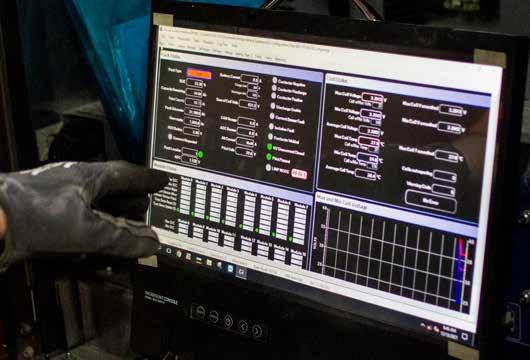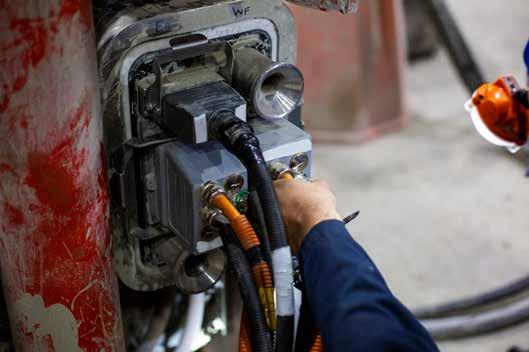
3 minute read
We decided to embrace battery electrification
recognize that greenhouse gas emissions around the world are climbing, and we want to try to reduce our greenhouse gas footprint. When the scoop is in full production, we’re reducing our GHG emissions by about 700 tonnes of CO2 equivalent per year compared to a diesel LHD.”
New Afton’s data on Sandvik LH518B shows that replacing one diesel loader with a comparable BEV is expected to reduce the mine’s total greenhouse gas emissions by as much as 2 percent in a year, assuming full production.
“That’s a really large number which, among other things, depends on how much we use the equipment and how much diesel we’re offsetting, but for an underground mine even replacing one piece of diesel equipment with battery-electric can have a major impact on your total GHG reduction.” application, a battery swap is the leading technology in our minds. When you’re relying on quick charge technology, every minute affects the equipment’s utilization.”
The energy consumption of Sandvik LH518B has been significantly less than New Afton’s diesel equivalent loader. “The overall energy cost compared to diesel is about 10.9 percent while operating,” says Prochotsky.
BATTERY SWAPPING ALSO enables New Afton to spread charging load over longer periods of time, helping to mitigate the aggressive power draw quick-charge solutions can place on a mine’s grid.
“Battery swapping technology is a great option for us because we only need to charge the batteries to just under the discharge rate,” says LaMarsh.
As New Afton expands down towards C-Zone, the mine is constrained by its original Lift 1 power supply of approximately 5 megawatts.
“We’re going to carry that same cable diameter down deeper, so when we talk about electrifying C-Zone, we do need to ensure that the power demand stays within our cable capacity,” says Prochotsky. “We see the best way to do that is to spread the load over a longer time period. We’re still using the same amount of energy by electrifying our production fleet, but we don’t have a peak power demand that exceeds the amount of power our cables can supply. Ultimately for C-Zone, we want to spread our power demand over the largest time possible.”
New Afton currently uses Sandvik LH518B in the mine’s Lift 1 haulage loop to load trucks and tram ore to the gyratory crusher. By 2023, the mine anticipates transitioning the loader to the new B3 cave to continue truck loading. B3 is essentially an intermediate zone that will take New Afton from its current Lift 1 mining area down to the future C-Zone.
THE C-ZONE BLOCK cave is about 550 metres below Lift 1 and 1,150 metres below surface. Mining at the future production area’s depth presents ventilation and operating cost challenges that Prochotsky expects BEVs and electrification can help mitigate.

“Mining economically at such depth can be complex, and we see battery electrification as one of the potential solutions to the challenge,” says Prochotsky. “The virgin rock temperature increases the heat of the level while in production, so that and ventilation constraints both favour battery-electric equipment.” diesel, you have to rev the engine to get all your hydraulic power, whereas in the BEV it’s the maximum amount of hydraulic power, right from the get-go. The instant torque is beneficial, both for mucking and for starting on a ramp. From a productivity and efficiency standpoint, it’s miles ahead of the competition in terms of the diesel equivalent, in our experience.”
Starting, stopping and tramming short distances have had the biggest impact on the battery-electric loader’s reduced cycle time, but Prochotsky says the biggest productivity driver is horsepower density.
New Afton Mine
“We have roughly four times the amount of wheel motor power in Sandvik LH518B than its diesel equivalent, so the up-ramp time is proportionately faster,” he says. “Tramming up ramp, on grade, we typically estimate our diesel LHDs to move at about seven to eight kilometres per hour, whereas we’re seeing speeds of 12 to 14 kilometres per hour with the battery LHD.”
THE LOADER IS also helping New Afton achieve its greenhouse gas reduction targets.
“Part of New Gold’s mission is to drive responsible mining,” Prochotsky says. “We
Sandvik LH518B is equipped with AutoSwap, a patented self-swapping system for the Artisan battery pack. The loader is also the first Sandvik BEV featuring AutoConnect technology, enabling an operator to swap batteries even quicker without exiting the cabin.
“The AutoSwap, AutoConnect technology has been smooth and seamless,” says Prochotsky. “It’s been a nice benefit for the operators, both in safety and efficiency, not having to exit the cab to unplug the battery.”
NEW AFTON EVALUATED different charging methodologies. LaMarsh said the ability to swap batteries quickly is an advantage of Sandvik BEVs, as the loader doesn’t need to be parked for an extended period.
“Sandvik LH518B was an attractive option for us because it has the battery swap technology as opposed to the quick-charging, and that really bodes well in a block caving operation,” says LaMarsh. “Battery swapping helps ensure a lot more utilization of the equipment, whereas with a fast charge, you do need to have downtime to facilitate that charging. For us here in a block caving










